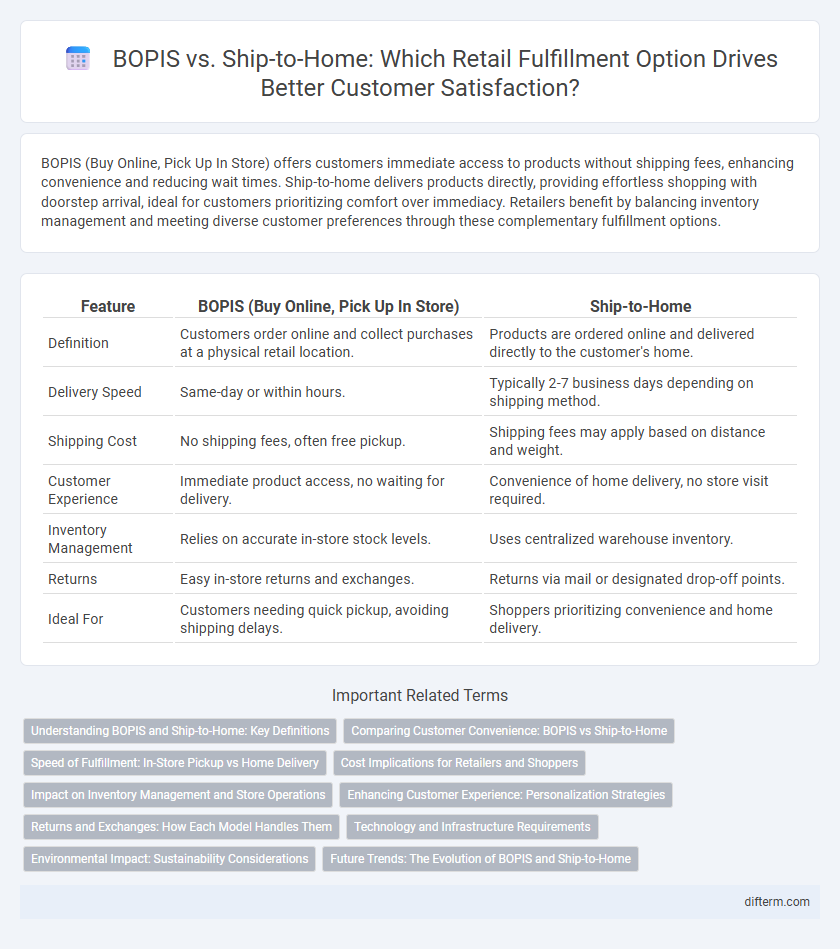BOPIS (Buy Online, Pick Up In Store) offers customers immediate access to products without shipping fees, enhancing convenience and reducing wait times. Ship-to-home delivers products directly, providing effortless shopping with doorstep arrival, ideal for customers prioritizing comfort over immediacy. Retailers benefit by balancing inventory management and meeting diverse customer preferences through these complementary fulfillment options.
Table of Comparison
| Feature | BOPIS (Buy Online, Pick Up In Store) | Ship-to-Home |
|---|---|---|
| Definition | Customers order online and collect purchases at a physical retail location. | Products are ordered online and delivered directly to the customer's home. |
| Delivery Speed | Same-day or within hours. | Typically 2-7 business days depending on shipping method. |
| Shipping Cost | No shipping fees, often free pickup. | Shipping fees may apply based on distance and weight. |
| Customer Experience | Immediate product access, no waiting for delivery. | Convenience of home delivery, no store visit required. |
| Inventory Management | Relies on accurate in-store stock levels. | Uses centralized warehouse inventory. |
| Returns | Easy in-store returns and exchanges. | Returns via mail or designated drop-off points. |
| Ideal For | Customers needing quick pickup, avoiding shipping delays. | Shoppers prioritizing convenience and home delivery. |
Understanding BOPIS and Ship-to-Home: Key Definitions
Buy Online, Pick Up In Store (BOPIS) allows customers to order products online and collect them at a physical retail location, offering immediate access and eliminating shipping fees. Ship-to-Home involves delivering purchased items directly to the customer's address, providing convenience and broader geographic reach. Both fulfillment methods balance convenience and speed, with BOPIS enhancing in-store traffic and Ship-to-Home supporting remote shopping preferences.
Comparing Customer Convenience: BOPIS vs Ship-to-Home
BOPIS (Buy Online, Pick Up In Store) offers immediate product access, eliminating shipping wait times and allowing customers to combine shopping with in-store visits. Ship-to-Home provides the convenience of home delivery, ideal for customers seeking a contactless experience and avoiding store trips. Both options enhance customer convenience by catering to different shopping preferences and lifestyles.
Speed of Fulfillment: In-Store Pickup vs Home Delivery
BOPIS (Buy Online, Pickup In-Store) offers faster fulfillment by allowing customers to collect orders immediately after processing, often within hours, eliminating shipping delays. Ship-to-home fulfillment typically takes several days due to packaging, transit, and last-mile delivery logistics. Retailers optimize BOPIS to boost customer satisfaction through instant access, while ship-to-home prioritizes convenience despite longer wait times.
Cost Implications for Retailers and Shoppers
BOPIS (Buy Online, Pick Up In Store) reduces shipping costs for retailers by shifting fulfillment to physical locations, lowering last-mile delivery expenses. Shoppers save on shipping fees with BOPIS but might incur transportation costs to visit stores, whereas ship-to-home offers convenience with potential higher delivery charges for both parties. Retailers balance operational costs and shopper preferences by optimizing inventory and leveraging data analytics to minimize expenses while enhancing customer satisfaction.
Impact on Inventory Management and Store Operations
BOPIS (Buy Online, Pick Up In-Store) significantly enhances inventory turnover by leveraging store stock for immediate customer fulfillment, reducing the need for large centralized warehouses. Ship-to-Home relies heavily on centralized inventory, which can streamline overall stock management but increases pressure on shipping logistics and delivery times. Store operations must adjust labor allocation and space usage to accommodate order picking for BOPIS, whereas Ship-to-Home impacts warehouse operations with increased packing and shipping demands.
Enhancing Customer Experience: Personalization Strategies
BOPIS (Buy Online, Pick Up In-Store) and Ship-to-Home both enhance customer experience through tailored personalization strategies leveraging customer data insights and shopping behaviors. BOPIS offers personalized in-store pickups with options such as preferred pickup times and exclusive local promotions, increasing customer convenience and engagement. Ship-to-Home benefits from AI-driven recommendations and customized delivery schedules, ensuring a seamless, personalized shopping journey that boosts customer satisfaction and loyalty.
Returns and Exchanges: How Each Model Handles Them
BOPIS (Buy Online, Pick Up In Store) streamlines returns and exchanges by enabling customers to return items directly at physical locations, often resulting in faster refunds and personalized assistance. Ship-to-Home returns typically require customers to ship products back, which can involve longer processing times and shipping costs, impacting overall satisfaction. Retailers integrating hassle-free BOPIS returns can enhance customer loyalty by offering convenience and immediate resolution compared to the traditional Ship-to-Home approach.
Technology and Infrastructure Requirements
BOPIS (Buy Online, Pick Up In Store) requires advanced point-of-sale integration, real-time inventory management, and seamless in-store pickup infrastructure to ensure efficient order processing and customer satisfaction. Ship-to-Home demands robust e-commerce platforms, scalable warehouse automation, and reliable last-mile delivery logistics powered by route optimization technologies. Both models leverage APIs and cloud computing to synchronize inventory data, reduce fulfillment errors, and enhance omnichannel retail experiences.
Environmental Impact: Sustainability Considerations
BOPIS (Buy Online, Pick Up In-Store) reduces carbon emissions by consolidating deliveries and minimizing last-mile transportation, offering a more sustainable alternative to Ship-to-Home methods that rely heavily on individual package shipments. Ship-to-Home increases packaging waste and delivery vehicle emissions due to separate, frequent shipments, contributing significantly to environmental degradation. Retailers aiming to enhance sustainability prioritize BOPIS to lower their carbon footprint and reduce packaging materials in their supply chain.
Future Trends: The Evolution of BOPIS and Ship-to-Home
BOPIS (Buy Online, Pick Up In Store) and Ship-to-Home models are evolving to integrate advanced AI and real-time inventory management, driving faster fulfillment and personalized customer experiences. Retailers are increasingly adopting hybrid approaches combining BOPIS convenience with ship-to-home flexibility to meet consumer demand for seamless omnichannel shopping. Future trends highlight increased automation and sustainable logistics practices, reshaping last-mile delivery and store pickup efficiencies.
BOPIS vs Ship-to-Home Infographic

 difterm.com
difterm.com